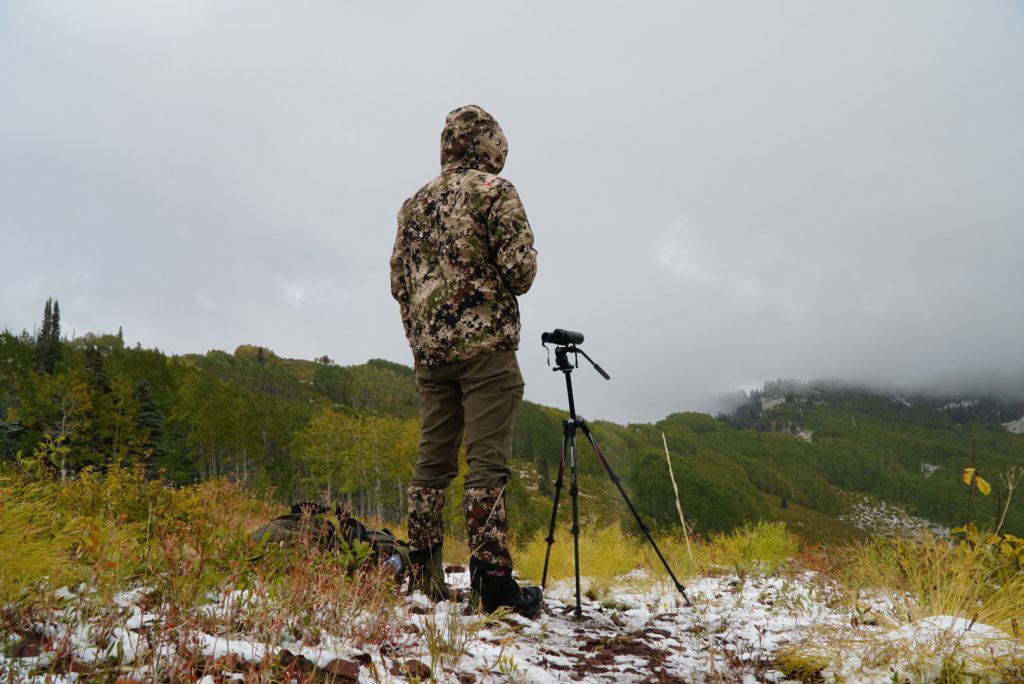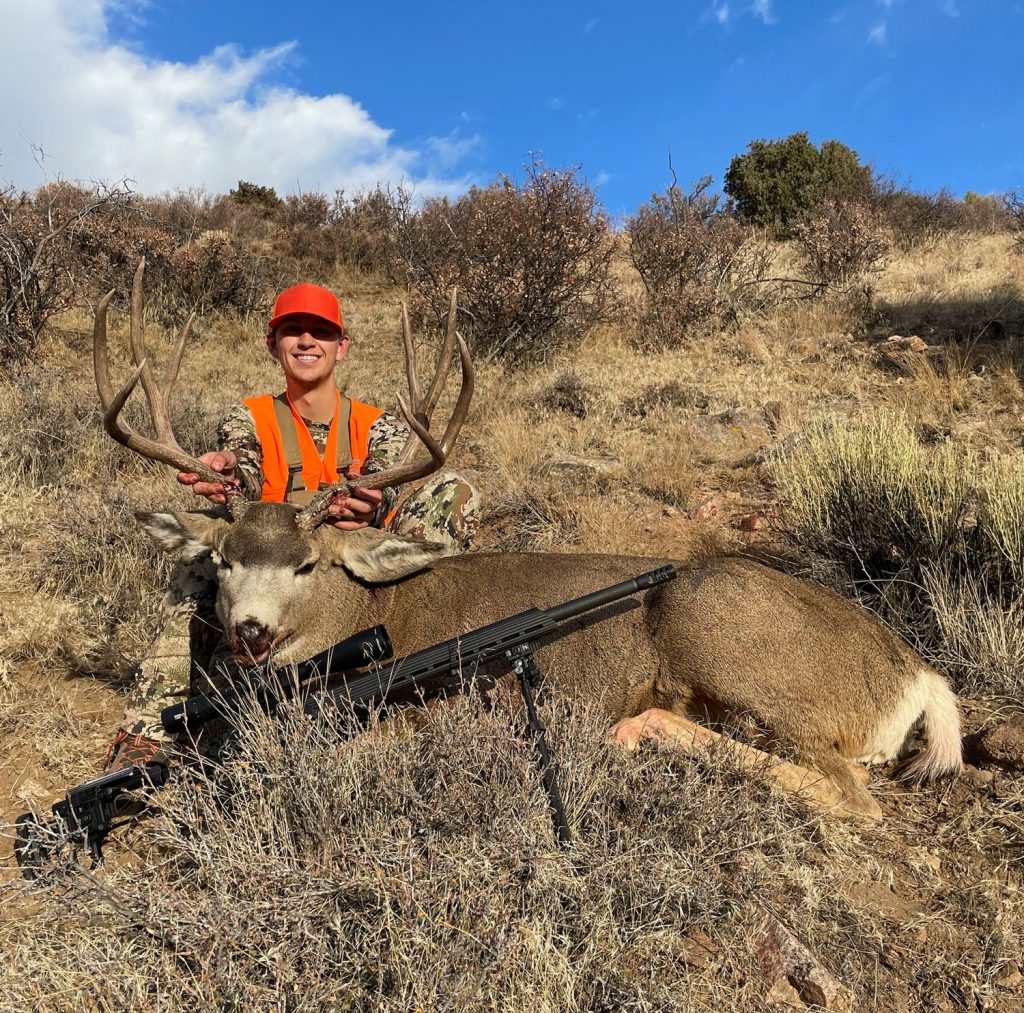Cold Weather Clothing Systems

Hunting in the late season when temperatures drop and weather is inconsistent can significantly hinder your hunting style and opportunities. I will never forget a hunt, when I was 16 years old. My friend and I were chasing late season mule deer in Utah. When we started hiking in the morning it was 30 degrees and no snow, by the end of the day it was in the teens and over 2 feet of snow. My memory from that experience was how freezing cold and wet I was.
Late season hunting can present many unique challenges, whether it’s heavy snowfall, extreme cold, high wind or non-existent animals. These extreme conditions should not stop you from hunting. I have hunted in weather from -10 degrees in the morning to 40’s during the day. These extreme conditions did not keep me from hunting, hiking, and stalking countless miles. Even though these conditions would make most people stay home. Being able to withstand whatever Mother Nature throws at you, as hunters, is key to being successful in the field!
It’s no secret that having a bullet proof layering system is paramount to your success in late season hunting. There are many brands of clothing in the market place that will work and at many different price points. I have tried many brands and types of clothing. In this article, I am going to talk about the items that I currently use. I have evolved to this system and these items after trying many different options over the last few years.
Layering System
Creating a layering system that works for you is paramount in enabling you to be comfortable, safe and keep hunting. This system stems from the idea that you add layers when you are cold and take them off when you are hot. A great example of this is hiking in to a glassing point before light, glassing for a couple of hours (not moving), then stalking a deer. Your gear should keep warm and comfortable. For late season hunts when weather rolls in you always see a significant drop in hunters because they are not comfortable. Below I will talk about my upper and bottom layering system with gear items that I use and trust.
Upper Body Layering System

This chart shows the different layers and how they work with each other.
The next-to-skin base layer is the foundation to your layering system. With two core material options to choose from, you can’t go wrong either way. Synthetic base layers are quick drying, ultralight, durable, and perform well in humid climates. Merino wool base layers are naturally odor-resistant, provide insulation while wet, and are ideal in arid climates.
Gear item: Blackovis NWT 150 Lightweight Merino 1/2 Zip Hoodie
The mid layer is an extension of your base layer for hunts in cold weather or worn as outerwear for active mid-season days. This layer I will wear pretty much all day throughout a late season hunt and is incredibly important. I always choose a hooded version for extra warmth and protection.
Gear item: Sitka Heavyweight Hoody
The next layer should be a jacket that is durable, wind and water-resistant and versatile. I always look for something that provides comfort in a wide range of uses and conditions. The Jetstream Jacket is great for fall all the way through late season hunts. It gives protection from wind and weather while still being quiet.
Gear item: Sitka Jetstream Jacket
The insulation layer is one of the most important layers and something I carry in the early season for emergencies and wear daily in the late season. This layer is worn over the base or mid-layer, and under rain gear in adverse conditions. Jackets either consist of synthetic insulation which is ideal for stop-and-go situations when breathability is a must or down insulation that is windproof and locks in body heat while you’re stationary.
I usually bring two different jackets when I am hunting. One is synthetic, that I will wear when hiking and hunting. The other is down and I only use while stationary and glassing.
Active gear item: Sitka Kelvin Active Jacket
Glassing or Stationary Jacket: Stone Glacier Grumman
Lower Body Layering System

Similar to upper body you can choose from merino or synthetic. The bottom layer is a foundational next-to-skin base layer that keeps the lower limbs warm during long periods of frigid inactivity while wicking moisture when on the move. I only wear a heavy base layer when temps drop below 15 degrees or I am not planning on hiking at all. I look for a base layer that can zip on and off. This allows you to keep boots on while taking the layer on/off.
Gear item: Kings camo 260 zip off merino bottom
For late season hunting I choose a pant that will be able to repel wind but still breathable for hiking. Find a pant that is versatile that will perform in these varied situations since late season hunting conditions can change in an instant.
Gear item: Sitka Mountain Pant
Insulation on your legs is paramount to staying warm while glassing. I have frozen many times because my legs were not warm. Insulated puffy pants are a game-changing piece of gear in adverse conditions. I usually only wear these when I am glassing or have minimal movement.
Gear Item: Stone glacier Grumman Down Pant
The last line of defense is rain gear. Rain gear is not only used for rain but a great layer to keep in warmth and protection. When temps really drop, I put my rain gear on above my puffy pants.
Gear item: Sitka thunderhead pant
When it comes to gloves, I am constantly exploring new options. My hands get cold and I wear gloves all year. The need for warmth and dexterity has led me to try several systems. While hiking, my hands can heat up and I prefer a lighter glove to protect against the wind. Mittens are a game changer and keep my hands warm on the coldest of days.
Gear item: Sitka Merino Glove
Gear item: Sitka Blizzard GTX Mitten
Footwear is a highly debated topic and the best system for each hunter will vary greatly. I hunt in uninsulated boots year-round while some of my hunting partners can hunt in 800-gram boots during the first week of September and still be comfortable. For cold weather hunts I wear a medium weight, well-cushioned sock that allows my foot to breath and to minimize sweating. Be careful not to go too warm with your boots or socks when hiking, because wet and sweaty feet will only lead to some major issues down the road during frigid temperatures.
Another must for my clothing when the snow begins is a good set of gaiters. These will keep your lower legs dry and ultimately keep your feet dryer. Also, as a plus gaiters will add warmth to your legs and feet.
Gear Item: HanWag Makra Combi GTX
Gear Item: Sitka Stormfront GTX Gaiter
Conclusion
I always try and buy the best gear that I can. That might mean saving up money or even just buying a different piece each year. Nothing beats high quality gear that that will keep you hunting. There is nothing worse than spending time and money on a hunt to just be miserable the entire time. High quality gear will make the difference in your hunt to be more successful. Blackovis.com has a great selection of brands, gear, camo and variety. Blackovis is my go-to store because of the wide variety of brands and gear.

-Dylan Cooley
